My Corner
Poetry
Recipe of the Month
The Daycare
Building Community
| Review Index |
|---|
It used to be here! |
-- Ray Bradbury
- Body Rolling ∗ ∗ ∗ ∗ ∗
by Yamuna Zake and Stephanie Golden

I was introduced to the concept of body rolling by my favorite masseuse who uses the theories behind it in her practice and teaches classes on how to use the balls. Not only have I never had a better massage, but this practice of body rolling allows me to keep up the work at home. The idea of using a ball to roll out your muscles is not new nor is it the exclusive property of Yamuna Zake; my doctor endorses it wholeheartedly as he says osteopaths have been using the idea for a long time. But this book and its companion break down the concept into usable chunks, so that you can feel confident fumbling about with it in the privacy of your own home. The book also stresses the dangers and I recommend that you take the time to read it before just jumping on and rolling away. There are parts of your body that you need to take extra caution with. I was also happy to learn that Yamuna Zake has a line of balls for sale that have the strength needed for body rolling; don't try it on your child's toy balls or on a soccer ball! Besides my trusty rolling ball I have the "foot wakers" and they are a little miracle all in themselves. The only down side to body rolling is that the book doesn't actually do the work for you; there's still the whole issue of making time and having the self-discipline to get down on the floor and do it. But at least this is one more option to add variety and fun to keeping in shape. Back to review index
- Creating a Home for Body, Soul and Spirit ∗ ∗ ∗ ∗
by Bernadette Raichle

It took me a long time to write this review because my second and third impressions of the book were much better than my first, so I had to absorb, digest, rethink and then reread in order to report back. The first part of the book seemed boring to me; I'm sorry there's no other way to say it. I want these reviews to be honest with little or no tap dancing, so there it is. Perhaps because the author is so careful to explain the fundamental aspects of her center with precise language and I tend to be impatient as a reader. You will have to judge for yourself if my perception is true for you. And yet, the second half of the book redeems the first well enough that I feel sorry for saying it. So enough said of the first half and the rest of the review will be on the second half.
The subtitle of this book is A New Approach to Childcare, but to those of us who operate daycare homes it seems like validation of the same old way we've been doing it for decades. I love the section Overview of General Practices that states concisely how this gentle form of child care is so beneficial for all of us. I am also captivated by the inclusion of the Maori culture, cultivating Te Whare Tapa Wha, the Four Cornerstones of Health: family, the physical realm, the soul realm and the spiritual realm. This gives us inspiration and a model to incorporate our own indigenous culture in our childcare practices. I love the way Raichle reminds me of the simple things I know:
- Experience shows that the children are most content in their play when the adults around them are engaged in real work. ..
- It is not our right to force our sympathy on the child....
- Finger games for the very young child should try to call the whole body into play rather than just the fingertips. This has a more rounded, whole quality and is less awakening...
But the true gold of this book for me comes at the very end, Chapter 15, Research and Reflection. Here the author discusses the creation of what she calls "pedagogical papers," This small section gives inspiration and guidance for those of us "in the trenches" to write up our observations and experiences, refine those writings and share them with others for further development. Only then can we clarify our thoughts when we're with the children and bring our work to the world instead of allowing those in classrooms and offices to define this precious, spiritual space where we dwell. Absolutely I'm glad this book is in my library and I'll be referring to it often as I work on this website. Back to review index
- The Diseasing of America's Children ∗ ∗ ∗ ∗
by John Rosemond and Dr. Bose Ravenel
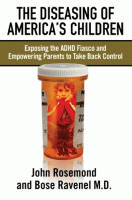
This book was not written to make anyone feel comfortable and for that reason it's the most valuable book I've read on children. Never have I found so much powerful information in such a usable format. But if you're not ready to question the status quo, hear the truth about childrearing practices you hold dear and make dramatic changes in how you think about your family, then don't bother picking this up. Like all real treasure, it's not for wimps.
While this book's title tells you it's about ADHD, I'm recommending it for all parents, teachers, grandparents and social workers. Even if your child hasn't been diagnosed I would wager that you know one who has. Perhaps you've suspected that some child in your world is a little "too hyper" or heard that even adults can be ADHD and thought of someone close to you. The first half of this book takes the ADHD bull by the horns and doesn't let go until every aspect of the disorder is dissected. With a historical overview that puts everything into perspective and a no-holds-barred approach to research that points fingers, names names and calls a fraud a fraud, Ravenel and Rosemond systematically clear up misconceptions, highlight hidden truths and answer every question you could possibly have. The style of writing is conversational but passionate, stern but with great humor. I found myself alternatively laughing and crying my way through the chapters.
The second half of the book offers sure-fire methods for raising children with (or without) ADHD. In fact, the authors offer real life examples of children who never showed their symptoms again after the parents made recommended changes. My years "in the trenches" with hundreds of children and families have shown me that the methods suggested here will make life immeasurably more sane for all families, with or without any imbalances.
Of course there's no book I agree with 100% so I'd be remiss if I didn't mention a couple places where I take issue with the authors. There's a small section on potty training that I feel reflects their lack of direct experience with the subject. As someone who has gone through potty training with more children than I can remember, I would suggest the authors have placed the exact unrealistic expectations on mothers in this area that they criticize other professionals for doing in academic achievement. There are some places where the wisdom of the grandmothers does not translate and this is one of them. I've heard that in Rosemond's other books he gives advice more to my liking and I look forward to reviewing them in the future.
The other topics I had a hard time swallowing were the review of how reading was taught and the recommendations for regulating television viewing. While I agree these topics are problematic, I think the details may warrant discussion and personalization, since schools and families are so unique. But these complaints refer to a handful of pages in a 250 page book that I cannot recommend too highly. Back to review index
- Feed My Lambs Feed My Sheep ∗ ∗ ∗ ∗ ∗
by Nadine Begin
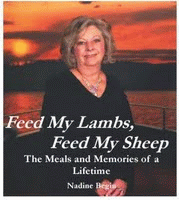
A beautiful book that has captured my heart! Inside this slim package are romance, passion, spirit, soul, life, death, poetry, music, laughter, tears and recipes! Could you ask for anything more? Nadine's story is a fairy tale that starts in the deep roots of a German Polish Russian family from Southern Michigan, Depression era. (Full disclosure: Nadine's Mother was my Great Aunt.) It weaves in and out of the convent, marriage, family, Europe and motherhood to arrive at the most gracious and beautiful bed and breakfast I've ever seen, right here in Traverse City. Though it could be a full length novel, she has told her story modestly with plenty of photographs, a scattering of poetry and the recipes that defined each of the stages of her life. With the simple dishes of her childhood (Dill Pickle Soup, Czarnina, Mystery Cake of 1932,) the food cooked in the convent (Babka, Golabki, Paczki,) the recipes she cooked for the assisted living home and the gourmet breakfasts that are famous at the Chateau, we wind our way along the path of someone who was called to feed people spiritually and deliciously. Never have I read a cook book with a story so tearful as the good-bye to her father when she left for the convent, so touching as her French marriage proposal or so joyous as the description of their house exploding with music. Never have I read an autobiography so down to earth and practical that I can't decide whether to keep it neat and clean in the living room library or in the kitchen with my cookbooks. Back to review index
- Get Over It and Boys ∗ ∗ ∗
by Daniel J. Hodgins
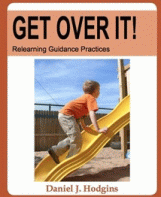
Dan Hodgins has been working with children for many years and travels far and wide speaking to other grown ups about his experiences and insights. I've gone to hear him several times during my career and never come away disappointed, always am inspired to do better and work harder. He's fun, entertaining and controversial in these times of pushed down academics and tight regulation. I highly recommend reading his books and going to listen to him if you have a chance. I even feature his newsletter (now discontinued) on my website.
Well, then why, you may ask, have I given these two books only three stars? Well, because after reading them both, while I love Dan's spirit, many of his techniques can't be put into practice in a mixed age group setting or in an environment that is smaller than a classroom. It's very evident that while he has vast experience, most of it is in a classic preschool where the age groups are segregated, the furniture is child-sized and there's so much open area that climbing apparatus is indoors. So for many of us raising children in homes, much here is irrelevant.
I think it would be a little better if Dan had pointed this out and tipped his hat to environments other than the ones he's referring to, but instead the reader is left to deduce this on their own, cherry pick a page here and there that can be put into operation and disregard the rest. This is hard because he has become a warrior for children and tends to champion his point of view so strongly that it's easy to feel "wrong" when you can't put all his suggestions into practice. But I think if you're going to be in the trenches with children you have to become like Dan; strong for them. So read the books, but remember, no one knows your situation, your environment or your kids like you do. Create your own philosophy! Back to review index
- Going Against the Grain ∗ ∗ ∗ ∗
by Melissa Diane Smith
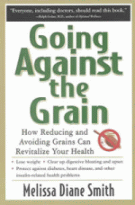
I would be able to write a more complete review of this book but I've already loaned it out to someone who I hope is taking it to heart, and you know if I've loaned a book as a recommendation then I really feel that it's got something important to say. There are many books that talk about grains and gluten intolerance but this book is the best I've found so far. Grains are more of a problem in our diet than the government food pyramid and the television commercials would have us believe. Though the kernels of grass are full of nutrients and undoubtedly a beneficial food, I'm sure humans were never meant to eat them as a staple in our diet. If we were they wouldn't be so small, so tough, so scarce in the wild and go rancid so easily. This book explores in a very user friendly form all the issues that too much grain in our gut can cause. In fact, it's so full of little quizzes and tests and basic information that for those who are more well-read on the topic it can seem a little tedious at times; thus only four stars. However, it gets the point across and offers a way to live in a world full of pastey foods by providing recipes along with all the new knowledge you'll gain about that base of the pyramid that could be the cause of many of your health problems. Hmmmmm, wonder who benefits from us staying sick? Back to review index
- The Heartmath Solution ∗ ∗ ∗ ∗
by Doc Childre and Howard Martin

I have always loved self-help books, as I am one of those bullheaded people who hate to seek assistance from anyone else and firmly believe I can learn how to do almost anything from a book. Ever since I was old enough to read I've preferred the practical, instructive book over fiction. So I know whereof I speak when I say that this is one of the most valuable self-help books out there.
I first learned about The Institute of Heartmath from a conference in Washington D.C. where Joseph Chilton Pearce was the keynote speaker. His insight into how our brains and hearts are vitally connected struck a rich chord with me, so when he emphatically endorsed Heartmath and the work they do there, I had to check it out for myself. The website has a lot of free material, encouraging tools, and information about work with schools, hospitals and businesses, all with the intent of creating more peace in our own hearts. And though I found lots of products there to buy you don't need any more than the instruction in this book to practice the helpful, healing techniques.
The Heartmath Solution is the basic manual that gives you practical, easy to employ tools to be able to think and live intelligently from your heart, rather than allowing lack of emotional management to cause dysfunctional chaos. For me the style of writing is a bit too simplistic and anecdotal. I like to just hurry up and get to the nuts and bolts of things but I realize for some people this type of over explanation is necessary to convince them that what they're reading is worthwhile. I was already convinced, so I found myself flipping impatiently over some pages that might have been helpful, thinking this book could have been written with half the ink. I wasn't disappointed though as my flipping brought me to step-by-step instructions for simple methods to tap into and work with the intelligence of heart. For people who practice meditation, these techniques will seem familiar, but with a little more structure aimed at producing specific results. There's nothing woo-woo or weird about this stuff, just breathing, focusing, cutting through the baggage and listening. The techniques have no-nonsense, descriptive names like Freeze-Frame, Cut-Through and Lock-In. So, you may ask, has it changed my life? Just like yoga, deceptively simple exercises are often surprisingly hard to fit into the well-worn grooves on our path. But I'm trying, and when I've been successful the results, yes, inspire me to keep it up and make this a way of life. Back to review index
- Home Away from Home ∗ ∗ ∗ ∗ ∗
by Cynthia Aldinger and Mary O'Connell
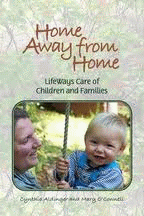
Families have gone through huge changes in the last few generations. One of those changes is in how we care for our children during the day. From time out of mind most mothers except for the privileged classes have had to labor all day. But until just recently they either kept their children with them or left them in the care of a relative or friend. Now a mother rarely finds either of these options available to her and so must hire a caregiver. Commercial child care can be roughly classified as either home care or center care. Precious little valid and reliable research has been done on pre-school child care and many of them just look like kindergarten. Likewise, in the Waldorf tradition, Rudolf Steiner had a lot to say about schools, but not so much about caring for children of the pre-school age. He gave us information about human development and lots of advice about how infants and small children should be clothed and fed, but it was expected that they would be cared for at home by their families so no formal instruction is written about creating a place to commercially care for small, unrelated children. The Waldorf schools for years held to the belief that families should make the greater effort to keep children at home until kindergarten thus avoiding the issue of how younger children would be cared for in a group setting.
But, in the cold northern land of Wisconsin, Cynthia Aldinger kept making noises about the families who were putting their children in daycare. She researched child care providers who were already applying Steiner's recommendations and philosophies to the infants and toddlers in their care. She realized that she was in the right place and the right time to address the need for formal training and standardization of early childhood caregivers in a Waldorf tradition and so Lifeways was born! Years ago I responded to her query in a Waldorf newsletter asking for input into this project and since then have enjoyed a long distance, warm and enlivening relationship with this inspiring woman. A handful of times we've had the joy of being at the same conference and exchanging real life hugs and conversation and the feeling is as if I was greeting an old friend. She is warm, perky and wise and the perfect person to start a quiet, important movement. This book describes her work.
From beginning to end, Home Away from Home answers every question you could possibly have about what Lifeways child care is all about. The format is lively and interesting with questions, answers, quizzes and lots of photographs. Philosophy, practices, licensing and advocacy are all thoroughly explored as well as the training she has created and offers. For anyone caring for children this book is a necessary addition to your library for all the insight it offers. All of us who create a space for children must think hard and carefully and often about how that space will reflect our highest ideals in a way that we can practically implement without burning out. Indeed, the true spirit of Anthroposphy is that we all must be free thinkers and determine our own best way in the world. In that light, there is no one source that can be a template to lay down and copy exactly. This book is not that, but rather a well to draw ideas and encouragement from. You may, after reading this, feel compelled to take the trainings and embrace LifeWays completely. You may, after reading this, take one small crumb and find a way to make it fit into your current practices. What matters is that you educate yourself about it and open your mind to these comforting, gentle practices. Children need to be cared for from the heart and LifeWays has created the model for that kind of care. Back to review index
- It's OK Not To Share ∗ ∗
by Heather Shumaker
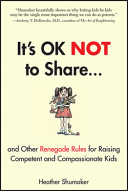
In the interest of full disclosure, this author goes to my church and we have had conversations but are not what I would call personal friends.
This book has been reviewed probably a hundred times, no exaggeration, with heaps of praise, so really Heather doesn't need one more review to help her along. However, because she's a local author several of my clients and cronies have asked me for my opinion on it. My first response was that really, the last thing I think the world needs is one more parenting book. Children don't burst from the womb with an instruction booklet but since Dr. Spock there are mere mortals who keep trying to correct that oversight. I feel that in the last twenty years parents have become way too insecure about their skills and instincts, mostly due to the throngs of authors and "experts" who are so happy to print their conflicting opinions, advice and admonishments.
This insecurity has led to a jumpy brand of overbearing, over-protective parenting among a portion of the well-read or those who watch day time talk shows. It seems that this book is primarily a push-back reaction to that competitive, over-achieving parent and the overly academic education they're demanding from our schools and preschools. I'm not convinced these parents need one more book to erase all the others, especially since Shumaker spends a huge portion of the book quoting those "experts," and ends each chapter with a list of "words to avoid." Nothing inhibits instinctiveparenting more than someone giving you a list of words not to say.
Not to say I disagreed with the premise of the book. On the contrary, one of the first chapters about preserving children's play had me hooked! I was in love with the author and convinced this was going to be right down my alley. I agree with reviewer Jeanette Wildman that there is really nothing renegade about the ideas. Rather, as the author herself poses, they are more retro than revolutionary. Most of these techniques are tried and true, common sense parenting. So why, you may ask, only two stars?
First, I think that the book could say everything it needs to say in about half the words. The organization is cumbersome and quote-heavy and several chapters are redundant. Parents don't have time to spare.
-
Second, Shumaker relies heavily on other people's experience and research. While this makes it a handy condensation of her favorite child development theories, in my experience there are actually very few valid studies that have been done on children. Most of them are the equivalent of observing adults in a doctor's waiting room and then calling it normal behavior. I prefer advice that comes directly from a person's own observations and experiences and to know exactly what those were so I can judge for myself their validity.
-
And I flat out disagree with several of the recommendations here. Shumaker of course allows her ideas will not all appeal to all and I think the last couple of chapters that discuss this should have been at the beginning of the book instead of the end. But too much of the book chides parents for one kind of parenting style only to recommend alternatives that in my experience are unsafe, ineffective or contrived.
What I like best about this book is that Heather shows a huge amount of respect for her Mother and how she was raised. I wish she had focused more on how she came to embrace her upbringing, instead of assuming that it's best for all families. This is perhaps the true renegade idea that is retro; that we learn about parenting from our elders, from those people intimately in our lives who have more experience and wisdom than we do. She doesn't care about the hundreds of experts that disagree with her, only about the ones who support her. This is the lesson I want you to take from her.
To be a truly renegade parent throw away the books and, like Shumaker, make up your own rules. Just don't assume they're right for others. Look at your personal history, your unique culture, your own beliefs and use common sense to raise your child. Listen to your heart and the wisdom that you've accumulated from your elders, your friends and your own observations. Let your children be children while you grow into the role of parent, day by day, mistake by mistake. Give them the parents you wish you had, be the kind of person you want them to grow up to be. Spend your precious time reading books to them instead of about them. Back to review index
- The Laws of Money, the Lessons of Life ∗ ∗ ∗ ∗ ∗
by Suze Orman
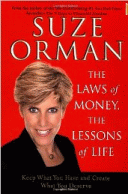
I know that Suze Orman takes a lot of criticism, but I love her. Some people are just born with an understanding of how to handle money and make it work for them, like some people can just handle dogs or horses or children. The rest of us need someone who can walk us through it, help us out of the mistakes we've made and not make us feel like complete idiots. For me, Suze Orman is that gal.
I've read several of Suze's books but I found this one at a yard sale and it's a winner. There are clear, concise chapters that take you, step by step through her Laws of money so that you can understand them and make them relevant (lessons) to your life. This book is, like so many of her books, a workbook with lots of spaces to write in so by the time you're done with it there's no excuse for not being able to internalize the message.
Since publishing this book, Suze has come out with several more. She has to be a prolific writer to keep on top of the economic scene in this country. You would think that her books would, like computers, become obsolete the minute they hit the shelves, but it's not the case. That's because in each of her books she weaves her wisdom about human nature and her precious philosophy about our sustenance and our livlihood. In each book she does this a little differently. So the Laws of Money are the unique feature of this one and how she teaches you to write them on your heart and commit them to memory. I'm keeping this book on my shelf, since I don't trust my memory. Those Laws of hers work for me. Back to review index
- The Sneaky Chef ∗ ∗
by Missy Chase Lapine
I will admit right away that I have not tried any of the recipes in this book so, when I do if they are wonderful and delicious, there will be more stars added to my rating. Right now Missy only gets two because she wrote a tediously long introduction explaining that the whole reason she had to resort to turning everything into puree and hiding it in foods that resemble the small list of stuff her kids would actually eat was because she completely pandered to their whining and complaining and her husband was absolutely no support at all. I was so disgusted by the time I was finally done with her saga that I almost ditched the book right then and there. But I forged on and became intrigued. (Also she does have a pretty nifty looking website that is worth checking out.) Her whole method of making food healthier is to cook and liquify lots of good stuff and then hide it according to color in dishes that will actually get into her family. I am 'old school' when it comes to feeding kids. A starving child will eat dirt and your child will not starve themselves. If their choice is to eat what's put in front of them or go hungry I promise that they won't go hungry for long and I really believe that the first step in creating a horribly spoiled child often happens at the dinner table. But if you don't think like I do and you are constantly trying to please your child's picky palate, then I have heard from parents like you that this book is very valuable as far as getting a little variety down the gullet of your prima dona, because it is true that nothing is 'health food' if they don't eat it. I would caution you, however, that every step of processing that you put a food through causes it to lose some nutrients and enzymes, so don't think that your green puree is as nourishing as those fruits and vegetables would be if your child learned to eat them fresh from the garden. Back to review index
- Making The "Terrible" Twos Terrific! ∗ ∗ ∗ ∗ ∗
by John Rosemond
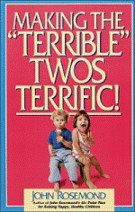
I'm a big fan of John Rosemond and his techniques in teaching parents to do their job well. This book is no exception and I enjoyed it thoroughly, just as I enjoyed the first one I read, The Diseasing of America's Children. This book is especially for the parents of very young children, but if you have a three or four-year-old who seems incorrigible, I suggest you start here to give you a foundation of what should have happened a couple of years ago between you and your short housemate. (Yes, I said the word should, and I don't use that term lightly.) After each chapter Rosemond has a series of questions and answers. This format helps to break up the huge amount of information and advice in the book and keep the conversational tone which makes him so easy to read and recommend. His great sense of humor also boosts him to the top of my list because if you can't laugh about your children you're doomed. As in his other book, he and I have different ideas about toilet training and probably always will. Perhaps if we sat down over coffee one day I would find that we were really more on the same page than I thought, but until then I have to believe we're not. However, in every other aspect I stand firmly by his advice. I'm especially grateful that he devotes a chapter to child care. This is a complicated subject many authors just gloss over by repeating the politically correct and industry approved viewpoints of the day. But Rosemond is never one to bow to convention and he makes no exception here. Not only is he brave and wise, but in doing so he sets an example for us to be heroes to our children. Back to review index
- Somewhere Towards the End ∗ ∗ ∗
by Diana Athill

I was gifted with this book by some dear friends at a time in our lives where we're both helping our parents age as gracefully as possible while staring the last half of our own lives squarely in the eye. So in this sometimes confounding time the honest words of spunky Diana Athill set my feet squarely on the ground and pointed my nose in the forward position. With the wisdom and candor of an old friend she speaks of her joys and regrets in a style that feels conversational instead of contrived; advising instead of lecturing. This woman's life was quite different from my own and yet with the common threads that run through all our lives I took away from her work the inspiration to stay a juicy, engaged woman. Thank you Peter and Dena! Back to review index
show your soul.--Clarissa Pinkola Estes